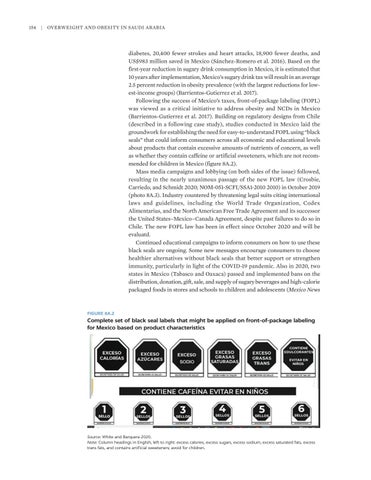154
|
Overweight and Obesity in Saudi Arabia
diabetes, 20,400 fewer strokes and heart attacks, 18,900 fewer deaths, and US$983 million saved in Mexico (Sánchez-Romero et al. 2016). Based on the first-year reduction in sugary drink consumption in Mexico, it is estimated that 10 years after implementation, Mexico’s sugary drink tax will result in an average 2.5 percent reduction in obesity prevalence (with the largest reductions for lowest-income groups) (Barrientos-Gutierrez et al. 2017). Following the success of Mexico’s taxes, front-of-package labeling (FOPL) was viewed as a critical initiative to address obesity and NCDs in Mexico (Barrientos-Gutierrez et al. 2017). Building on regulatory designs from Chile (described in a following case study), studies conducted in Mexico laid the groundwork for establishing the need for easy-to-understand FOPL using “black seals” that could inform consumers across all economic and educational levels about products that contain excessive amounts of nutrients of concern, as well as whether they contain caffeine or artificial sweeteners, which are not recommended for children in Mexico (figure 8A.2). Mass media campaigns and lobbying (on both sides of the issue) followed, resulting in the nearly unanimous passage of the new FOPL law (Crosbie, Carriedo, and Schmidt 2020; NOM-051-SCFI/SSA1-2010 2010) in October 2019 (photo 8A.3). Industry countered by threatening legal suits citing international laws and guidelines, including the World Trade Organization, Codex Alimentarius, and the North American Free Trade Agreement and its successor the United States–Mexico–Canada Agreement, despite past failures to do so in Chile. The new FOPL law has been in effect since October 2020 and will be evaluatd. Continued educational campaigns to inform consumers on how to use these black seals are ongoing. Some new messages encourage consumers to choose healthier alternatives without black seals that better support or strengthen immunity, particularly in light of the COVID-19 pandemic. Also in 2020, two states in Mexico (Tabasco and Oaxaca) passed and implemented bans on the distribution, donation, gift, sale, and supply of sugary beverages and high-calorie packaged foods in stores and schools to children and adolescents (Mexico News
FIGURE 8A.2
Complete set of black seal labels that might be applied on front-of-package labeling for Mexico based on product characteristics
Source: White and Barquera 2020. Note: Column headings in English, left to right: excess calories, excess sugars, excess sodium, excess saturated fats, excess trans fats, and contains artificial sweeteners; avoid for children.






